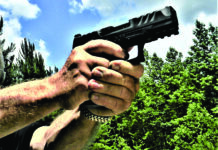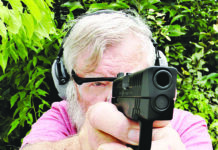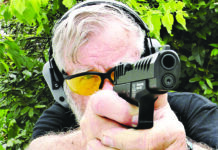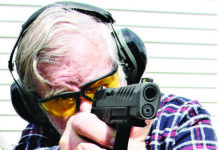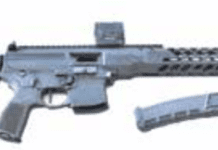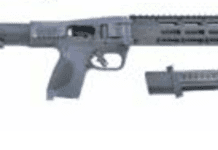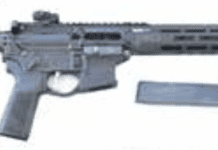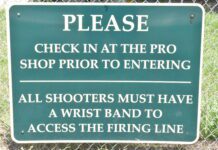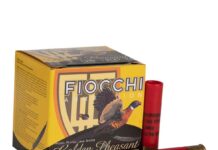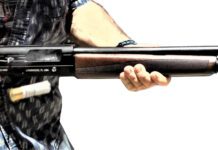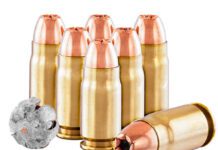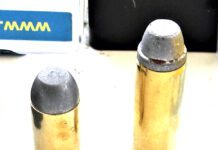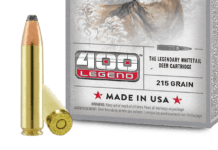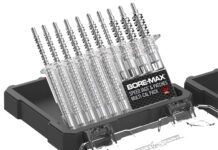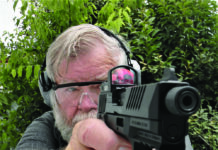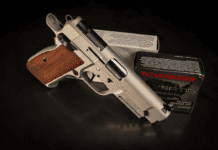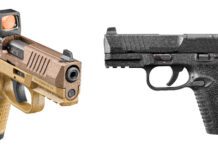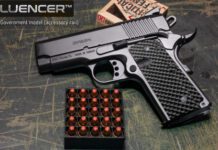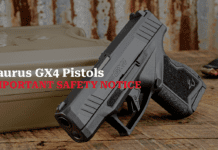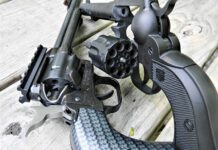2015 Guns & Gear ‘A’ List
Toward the end of each year, I survey the work R.K. Campbell, Roger Eckstine, Austin Miller, Ray Ordorica, Robert Sadowski, David Tannahill, Tracey Taylor, John Taylor, Rafael Urista, Ralph Winingham, and Kevin Winkle have done in Gun Tests, with an eye toward selecting guns, accessories, and ammunition the magazine's testers have endorsed. From these evaluations I pick the best from a full year's worth of tests and distill recommendations for readers, who often use them as shopping guides. These choices are a mixture of our original tests and other information I've compiled during the year. After we roll high-rated test products into long-term testing, I keep tabs on how those guns do, and if the firearms and accessories continue performing well, then I have confidence including them in this wrap-up.— Todd Woodard
New Gun Products 2015
There's a whole lot of new products coming out at the end of 2015, well in advance of the massive outpouring that's introduced every new calendar year at the S.H.O.T. Show. Here's a look at just a few of the new products I've seen that may be interesting to gunnies:
ARES Defense Now Shipping MCR Sub-Carbine. ARES Defense Systems is now shipping its MCR Sub-Carbine. The ARES MCR Sub-Carbine is a lightweight, semi-auto 5.56 NATO-caliber firearm featuring gas-piston operation, a 3-second quick-change barrel system, and a left-side folding stock assembly that telescopes for adjusting the length of pull. The charging handle is ambidextrous and interchangeable with standard AR15/M4 charging handles, to suit user preference. Suppressor capable and able to be fired with the stock in any position, the MCR has an edge on many of the folding-stock and telescoping PDWs. The internals are billet machined from aircraft-grade alloys and heat-treated. Aluminum components are Type III, Class 2 hard-coat anodized to MIL-A-8625F for maximum corrosion and wear protection. Also available to complement the MCR Sub-Carbine is an optional SKB briefcase with custom-cut foam insert that holds the firearm, six 30-round magazines, a cleaning kit, operator's manual and storage space for a suppressor or other accessories.
22 LR Pistols Based on Rifles From Ruger, MRI, and Mossberg
The Ruger 10/22 rifle is the most customizable semi-automatic rimfire rifle on the market. In fact, some manufacturers have taken 10/22 rifles and radically converted them to make highly accurate target rifles or built in internally-suppressed barrels for low-noise shooting. Some have molded shells to make the 10/22 look like an M1 Carbine or a Thompson submachine gun, while others have made them into pistols, as this test recognizes. By reconfiguring the buttstock into a pistol grip and reducing the barrel length, the same receiver is used to create an entirely different class of pistol. We wanted to take a look at these pistols, two derived from a Ruger 10/22 and one from the Mossberg 702 Plinkster, to see what they offered other than just an abbreviated variant of a long gun.
We secured a slightly used model of Magnum Research's Picuda that was mounted with a fixed 4x-power Leupold scope (#58750; $440). Ruger debuted its own 10/22 pistol in 2008, calling it the Charger, and ended production in 2012 — only to reintroduce a revised variant in 2015. The original Ruger Charger was very similar in appearance to the Magnum Research Picuda, while this new Ruger 22 Charger we tested is more refined, with plenty of features to like. Mossberg's 715P pistol came out in 2014. While the Magnum Research and Ruger are similar since they share a similar operating system, their design appeals to shooters and hunters who desire precision shooting, while the Mossberg is made to satisfy plinkers.
All three pistols use a simple blowback mechanism that is the same mechanism as used in the rifle. The pistols look ungainly since they use the same receivers as the rifles. The barrels, however, are cut down in all three models. The Magnum Research and Ruger reconfigured the rifle stock to a pistol grip sans buttstock. Though the Ruger and Magnum Research grip/stock were similar, the Ruger offered more options, so a shooter can set up the pistol to suit his shooting needs.
To make the 715P, Mossberg basically takes a 702 barreled action and sandwiches it between two polymer halves to give the pistol the appearance of an AR-15 pistol. The similarity to an AR pistol is only cosmetic, as the 715P functions just like the 702. Consider it a sheep in wolves' clothing. The Charger 22 and Picuda come optics ready, requiring a user to invest in a optic and rings. A Weaver rail is built into the Magnum Research pistol, while the Ruger comes with a Picatinny rail screwed into to the receiver. We mounted a BSA Edge 2-7x32mm pistol scope (#PS27X32; $140) on the Ruger. The Mossberg has open sights and is good to go out of the box, but to keep the playing field relatively level we added a CenterPoint Tactical 30mm Enclosed Reflex red-dot optic (Model #72601; $30). Mossberg offers a red-dot sight as an option on other 715P models. The CenterPoint optic co-witnessed with the top quarter of the iron sights on the 715P, which we liked. The rail on the Mossberg looks like a Picatinny/Weaver style, but it is not, as we discovered when mounting the CenterPoint Tactical red dot. Here's more about what we discovered about these rimfire rifles converted to pistols.
S&W J-Frames Now With Lasers
Smith & Wesson Corp. will make three more lightweight J-Frame revolvers — the Model 442, Model 637, and Model 638 — available with factory installed LaserMax CenterFire laser sighting systems. They join the popular Model 642, which was equipped with a factory-installed LaserMax CenterFire laser in January 2015.
The factory-installed CenterFire laser is designed to fit the revolver frame. Located under the bore, the new sight features LaserMax's Controlled Activation feature, which enables the user to operate from concealment without revealing his or her position.
Springfield 9mm 1911s: Loaded Versus Range Officer Showdown
There are many good reasons for purchasing a 1911 in the non-traditional 9mm Luger cartridge. Compared to 45 ACP, 38 Super, and 10mm, 9mm Luger ammunition is less expensive and easy to come by. Also, the 9mm is only improved when fired from the 1911, with that platform's solid ergonomics, reliability, and distinctive appearance. In a 1911, the 9mm is easy to shoot well, despite a history in which 9mm target guns were seldom as accurate as a properly set up 45. As it turns out, the 9mm 1911 with modern ammunition is plenty accurate. Some shooters might also worry that 9mm 1911s might be less reliable, but we can only say that in our small sample of hundreds of rounds, two tested 1911 9mm handguns were reliable.
Where do such guns fit in? For one, the 9mm 1911 is a great target and competition handgun. Just as a cowboy-action shooter may choose a 38 Special SAA for economy and low recoil, an IDPA shooter may find the 9mm affords economical practice without creating waves in the arm from recoil. The self-defense shooter need not worry either, because with +P loads, the 9mm is no slouch in the wound-ballistics department.
We have had calls to choose between two closely matched stablemates from Springfield Armory, and both the Loaded Target PI9134LP and the Range Officer PI9129LP are traditional full-size 9mm pistols. This simply means that they are based upon the 45 ACP's frame. They are very similar to 38 Super pistols, save for a breech face of 0.384 versus 0.405 inch for the 38 Super. By changing a barrel and opening the breech face, the 9mm pistol may be converted to 38 Super. As you may imagine, converting a 38 Super to 9mm is a bit easier since the larger breechface usually works okay with both cartridges. (Exceptions: The Para USA LDA 9 and the Springfield EMP 9mm are 9mm pistols that are a bit smaller in dimension than the full-size Springfield pistols. They cannot be converted to the 38 Super.)
The full-size 9mm handguns are designed to fill a niche for those favoring the 9mm, or those simply wishing to own a lighter-kicking 1911 than one chambered in 45 ACP or 40 S&W.
The 9mm Range Officer has the same forged national match frame and slide as the Trophy Match and TRP 1911s. It gets the same precision fit as those more expensive pistols, Springfield says. Likewise, it uses the same match-grade stainless-steel barrel and bushing and is topped with a fully-adjustable rear target sight. This is a great help to us in adjusting point of aim to point of impact when we're shooting different bullet weights. It has a single-sided thumb safety.
The Loaded 9mm Stainless Steel has a polished finish on the flat surfaces and bead-blasted matte finish on the rounded areas. The 5-inch barrel is a match-grade stainless steel unit. The slide features slanted serrations on the front and rear, where the RO has only rear cuts. The mainspring housing is flat and includes the company's integral locking system, or I.L.S., which replaces the mainspring housing of the handgun. When engaged, the I.L.S. prevents the hammer from moving by locking the mainspring cap, making the gun inoperable. Elsewhere, the pistol has a lightweight Delta hammer and a beavertail grip safety with raised memory pad for positive engagement. The extended thumb safety is ambidextrous, and its long aluminum match-grade trigger separate it from the RO. The pistol is fitted with a two-piece full-length guide rod. The grips are held in place with Torx grip screws that look nice and distinguish it from the RO.
During the evaluation, both handguns were field stripped. Interestingly, the Range Officer slide easily slipped on the Loaded Model Frame. The Loaded Model slide, however, was too tight on the Range Officer frame to function. Since modern 1911 handguns are not disassembled and thrown into a barrel on Guadalcanal for cleaning, then assembled regardless of original set up, this is acceptable and also interesting. The Range Officer seemed to have the tighter barrel bushing lockup. The barrel was a tight fit overall. We were surprised that the barrel bushing was only finger tight with the Range Officer.
But what matters is the shooting, and what our team found is that these 1911s chambered in 9mm Luger make for a very pleasurable shooting experience. An accurate 1911 in 9mm is even more enjoyable. Here's more of what we learned about them when firing them side by side:
In Texas, Better Protection for Class 3 Devices Is Coming
In about a month, gun owners in Texas and visitors to the state will feel the positive effects ofSB 473, a bill which Texas Gov. Gregg Abbott signed into law that extends protections for Class 3 devices, such as short-barreled rifles (SBRs), suppressors, and "any other weapons," as defined by the National Firearms Act. SB 473 will take effect on Sept. 1, 2015.
A Solution for 10mm Misfeeds
Re "The A-Team: 1911
Handguns & Gear" E-Book
Several years ago, I was fortunate to find an early Colt Delta Elite for a very reasonable price. It came with three 10mm magazines. After firing a box of 10mms and waiting for my eyebrows to grow back, I decided to drop a 40 S&W barrel into it. Ordered an appropriate Kart barrel, two Metalform mags, and Jerry Kuhnhausen's book on the gun from Brownells, and went to work. Everything worked out great except the mags. They fed sporadically and would not lock the slide back after the last round was fired. Apparently, the small platform on the followers did not make sufficient contact with the slide stop to push it up into its proper position. When I reordered with another mag, I had the same problem. What to do? I simply loaded up the original 10mm mags with the 40 S&W rounds and have been shooting both factory and reloads without a hitch ever since. They work great. By the way, I recall reading more than 40 years ago, if you are having trouble with 9mm mags in a 1911, use 38 Super mags instead. Keep up the good work, I enjoy your unbiased and objective tests.
Replacement AR-15 Triggers From Ruger, HiperFire, and Rise
Improving the trigger in an AR-15 can make a big difference in performance of the rifle. Whereas handgun triggers are generally retained and modified, the AR-15 lends itself more easily to replacement of its trigger group, such as we did in this review. Our test triggers were two from HiperFire, the $89 HiperTouch EDT AR-15/AR-10 Enhanced Duty Trigger and the $215 HiperTouch 24E Elite, Ruger's new Elite 452 AR Trigger 90461, $159, and the $259 Rise RA-535 Advanced Performance Trigger.
Our test-bed AR-15 was the Bushmaster "preban" XM-15 carbine previously tested in the August 2003 issue of Gun Tests. The XM-15 featured a 1:9 twist 16-inch-long barrel chambered for 5.56mm ammunition. While its trigger continued to be extremely consistent, the pull weight measured at a full 8.5 pounds with little or no take up and a hard break. In terms of function, there was nothing really to complain about other than it being inordinately heavy, a characteristic we were looking to change. For optics we retained the Sightron S33-4R 1X-magnification red-dot scope that had been in place since about 2005. With four different illuminated reticles to choose from, we picked the single-dot reticle with a size of 2 minutes of angle at 50 yards.
We considered both ease of installation as well as performance in our judging standards. The Rise Armament trigger was a sealed drop-in module, but the other triggers required assembly. By working with both a neophyte builder and an experienced gunsmith, we were able to gain valuable insight on the process. Matt Suddeth of Katy, Texas — a brilliant knife maker with a reputation for exacting rifle work — advised us on aspects of the installation. Once the triggers were configured properly, we measured their pull weights 10 times immediately following installation then 10 more times after our range tests with a Brownells Recording Pull Gauge (174-025-250WB, $125).
Our first test was to make sure the safety remained fully functional. All four triggers passed this test. Then we tried an impact test with the selector in the fire position. With the gun empty, safety off, this consisted of crouching down so that our head was below the line of the muzzle and slamming the buttstock against a concrete floor three times. We wanted to see if we could get the trigger to release the hammer by means other than pulling the trigger. None of the units failed this test. In addition, none of the triggers exhibited common flaws such as creep, grittiness, or dead spots.
Live-fire tests were performed in two segments, each fired offhand (standing unsupported) from the 50-yard line at American Shooting Centers in Houston, Texas. The targets we chose were proprietary to the range, displaying a white 3.9-inch 10-point center containing a 2-inch-diameter X-ring. The 9-point ring consisted of an orange circle, producing an overall diameter of 8 inches. Segment one was a practice session consisting of 50 rounds performed with budget ammunition, American Eagle 5.56x45 55-grain FMJ XM193BLC100, sold in 100-round packaging. During this period, we experimented with different ways the shooter could work the trigger. We fired using the slowest, most controlled press, we could muster. We also moved the trigger fast. We shot strings of fire holding the trigger fully rearward after ignition and then practiced a slow release until the mechanism reset and fired again. We did this as rapidly as we could as well as with measured precision.
After a timed 3-minute rest period, segment two was fired for shots of record using premium ammunition. Limited to ten shots standing unsupported, we chose Black Hills 5.56mm 69-grain OTM (open tip match, featuring the Sierra Match King BTHP bullet). Did any of these triggers make our test gun easier to shoot accurately? Here's what we found out:
An Amusing and Useful Idea from Mark LaRue, Owner of LaRue Tactical
If 2 guys at the range both have iPhones...
Apex Announces New Flat-Faced Action Enhancement Trigger for Sig Sauer P320
Apex Tactical Specialties has announced its new Apex Flat-Faced Action Enhancement Trigger, about $45, for the popular SIG Sauer P320 series of pistols.
Magnum Research Desert Eagle Animal Prints
Magnum Research Introduces New Animal Prints on Desert Eagles
Following the success of its Cheetah print for the Desert Eagle, Magnum Research has introduced two new prints — the Kryptek Highlander and the Snakeskin, available in either .50 AE or .44 Mag.
Tactical Pump Shotguns: CZ-USA HC Versus Weatherby
Specific-use firearms such as tactical shotguns that are designed for self-defense situations are held to a higher standard than other shooting tools. If a self-defense shotgun fails to function or inadequately performs at the wrong time, there is no such thing as a do-over. Admittedly, most of these shotguns will never be fired in a life-or-death situation and generally don't see a lot of time on the shooting range. That does not mean the tactical shotgun owner does not demand the shooting tool, when it is necessary, handle its duties in an efficient and effective manner.
This is the first of two tactical pump-action shotgun evaluations. The next head-to-head match will feature a Tristar TEC-12 Pump/Auto 12 gauge listing for $689 against a Mossberg Model 590 Magpul Pump 12 gauge listing for $773. In that review, we will also name Our Pick of the four shotguns put through exactly the same test drills.
For this test, we selected a couple moderately priced pumps to see how they fared on the shooting range and whether they met the high standards of a firearm that might mean the difference between life and death. The two 12-gauge pump-action shotguns, both available for less than $500, that we put through their paces are the Weatherby PA-459 TR with a manufacturer's suggested retail price of $499 and the CZ-USA Model 612 HC-P 12 gauge (last reviewed in October 2013) listing for $366.
When a shooter absolutely, positively, without-a-doubt has to stop a threat, he or she can't have doubts about whether a firearm will function in a proper and effective manner. Not only does the self-defense firearm have to perform well, a shooter must have confidence the pattern will be placed on target in an effective manner. Also, a key element in any self-defense training is that the shooter is responsible for any lead that comes down the barrel in a shooting situation. Wounding or killing an innocent bystander with an errant pellet or slug is simply unacceptable on both moral and legal levels.
Spending time on the range to know how well a shotgun performs is a necessary factor with self-defense shotguns. Understanding that a typical tactical firearm packs quite a punch on both ends, we endured quite a bit of shoulder shock in conducting evaluations on these firearms. We encourage individuals who purchase these firearms do the same so they will become familiar with their specific self-defense tool.
Our ammunition for putting the two close-quarter shotguns into play included Rio Royal Buck 2.75-inch loads moving nine pellets of No. 00 buckshot at an average muzzle velocity of 1,345 fps; and Winchester Reduced Recoil Winlite 2.75-inch loads pushing 0.9-ounce 400-grain Sabot Slugs with an average muzzle velocity of 1,450 fps. In addition, our repeated function-fire and cycling rounds as part of the testing sequence were Remington ShurShot Heavy Dove 2.75-inch loads with 11⁄8 ounces of No. 6 shot moving at an average of 1,255 fps.
Rather than the standard patterning board used for our other shotgun testing, we utilized Birchwood Casey Eze-Scorer 23-inch by 35-inch Bad Guy and the same size Targets Online paper images of potential threats for our shots in home-defense simulations; and Champion VisiColor Zombies 12-inch by 18-inch Slasher Tusks targets for slug shots at 25 yards. On the zombies, only head shots were counted as acceptable results with the slug ammo. Here are our findings:


